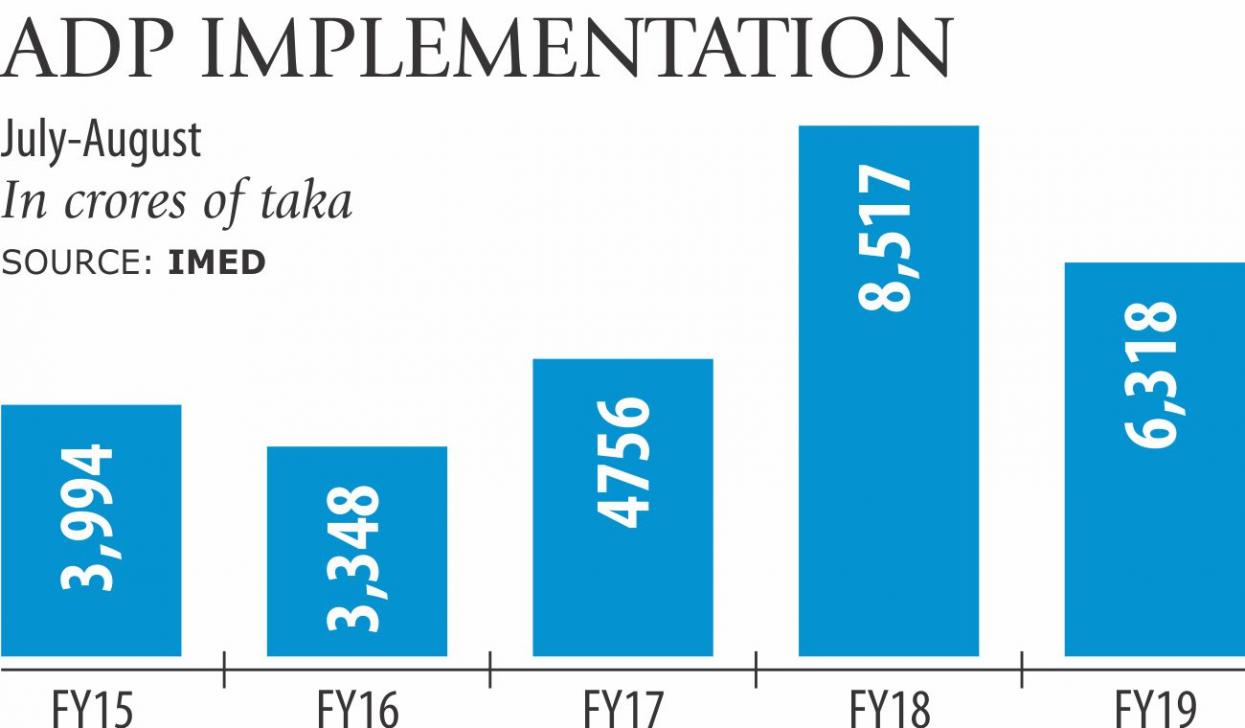ADP spending slows as ministers busy with polls

Involvement of ministers and lawmakers in campaign ahead of the upcoming national elections has slowed development spending to 13.75 percent of the total outlay in the first four months of 2018-19.
Ministries and divisions spent Tk 24,864 crore against the total outlay of Tk 180,869 crore in the July-October period, according to data from the Implementation, Monitoring and Evaluation Division (IMED).
The spending was Tk 23,815 crore or 14.51 percent of the total outlay in the same period the previous year.
Though the ADP implementation was slightly higher this fiscal compared to the last one, it dropped in percentage as the ADP size was increased.
In the election year, the ministries and divisions were not much interested in realising the existing projects, rather they preferred approving new ones, a planning ministry official said.
On the eve of the upcoming national elections, the ministers and MPs are busy in electioneering, he said.
As they are preoccupied with getting nominations and related activities, they cannot give much attention to the ADP implementation, the official said.
The official said they hope the ADP implementation would pick up from January next.
However, the Executive Committee of the National Economic Council (Ecnec) has been on a project approval spree.
At least 82 projects, involving Tk 88,782 crore, have been approved in October.
Two Ecnec meetings in the first week of the current month had approved 67 projects involving Tk 116,921 crore.
Between July and September, 75 projects, involving Tk 56,819 crore, have been okayed.
On the slow ADP implementation, Planning Minister AHM Mustafa Kamal had earlier said most of the projects were taken for roads, schools and madrasas, for which the construction materials were not available on time.
The private sector does not have any automated brick field, so it does not make the required number of bricks showing the excuse of rain, he said.
“They wait for the rainy season to end to start making bricks,” he said, adding that he would advise the government to set up automated brick fields to produce bricks for public sector's construction works.
Historical data shows that the pace of the ADP implementation becomes very slow at the beginning of a fiscal year.
In June, the Finance Division empowered the project directors with the right to release the first and second quarter funds by themselves instead of waiting for approval from the ministries or divisions concerned, an exercise that eats up two to three months.
Not only the finance ministry, Kamal also met with secretaries of different ministries and divisions in early August to inform them about the government's position on speeding up implementation of development projects in the election year.
Of the total ADP, Tk 14,800 crore of the government's own fund was spent in the July-October period of 2018-19 against an allocation of Tk 113,000 crore while the implementation rate was 12.01 percent last fiscal.
Some Tk 8,360 crore was spent from foreign aid, which is 13.93 percent of the allocation.
In the current fiscal year, total foreign aid allocation was Tk 60,000 crore. In the last fiscal, the foreign aid utilisation was 18.40 percent of the total outlay for the same period.
However, this time the performance of state-owned enterprises improved: they spent Tk 1,704 crore in the first four months of the fiscal year, which is 21.66 percent of their allocation. It was only 14 percent during the same period last fiscal year.
Of the large 15 ministries and divisions whose allocation was almost 80 percent of the total ADP, performance of seven ministries and divisions hovered between 3 to 8 percent only.
These are road transport and highways division, railways ministry, bridges division, primary and mass education ministry, secondary and higher education division, water resources ministry, and posts and telecom ministry.
However, three ministries and divisions were the top performers, of which power division implemented 28.21 percent, local government division 20.86 percent and power and mineral resources division 33.87 percent.
